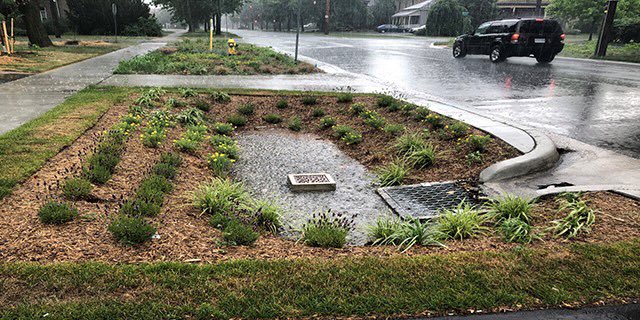Environment Day - Rain Garden
Rain Garden
What is a Rain Garden?
Rain gardens are garden beds that slow down and temporarily hold stormwater (rainwater and melted snow) runoff from rooftops, driveways, and roads. They are an easy, sustainable way to prevent pollution from entering our waterways.
Why make a Rain Garden?
- Remove pollutants from runoff before it enters rivers and waterways.
- Support biodiversity by providing food and shelter for essential insects and birds;
- Recharge groundwater: rain gardens help the ground soak up to an extra 30% of water, which helps in managing less flooding and less erosion
- Low maintenance: they require little or no watering and no fertilization
- Mosquito free: mosquitoes require 7-12 days of stagnant water, rain gardens absorb water within 48 hours
The mechanics
- Duration: 6-8 hours, depending on the size of the rain garden.
- Cost: $10 to $40/sq. ft.
- Topsoil
- Native plants
- Mulch
- Participants: 6-20, depending on the size of the rain garden.
- This activity is family-friendly and accessible to anyone who has the mobility to partake in gardening and can get to the areas where the rain garden will be.
- Intensity/Effort: Medium-high (digging, shovelling, bending or kneeling for sustained periods, carrying bags of soil and/or mulch)
- Location: When considering rain garden locations, pay special attention to:
- Rainwater flow: will you need to redirect water through a downspout?
- Proximity to buildings: build the garden no closer than 3 m to neighbouring properties
- Proximity to septic systems: keep at least 4 m away from septic bed on flat ground and 15 m away if uphill of a septic system
- Proximity to slopes: 15 m away from any steep slopes to avoid landslides
- Utilities: contact utility companies to locate underground utilities, as some can be relatively shallow and you will need a minimum depth of 2.5' for the garden
- Drainage: avoid areas with poor drainage
- Permits: Are you able to obtain the permits needed to dig in this area?
- Materials:
- Topsoil
- Mulch
- Native plants
- Appropriate clothing, footwear, and gardening gloves
- Gardening tools, such as hammers, shovels, rakes, garden hose, strings and stakes, wheelbarrows
- What to grow?
- Native plants: grasses, flowering plants, and shrubs that are suited to local growing conditions and support local wildlife
- Create and print educational materials to provide to reporters, public officials, and those who aid in the construction
Additional resources
- Rain garden cost calculator
- Video - Municipal Government of London, ON
- Guide to building and maintaining a rain garden
- City of London - Stormwater information



Click the following links to learn more about each project: Main Page | Pollinator Garden / Butterfly Garden | Rain Garden | Waste Clean-Up | Invasive Plant Clean-Up | Sustainability Fair | Nature Activities for Kids | Movie Night | Earth Balls / Seed Bombs | Tree Planting | Bee Hotel

.png)












